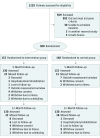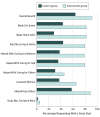Effect of a Biobehavioral Environmental Approach on Disability Among Low-Income Older Adults: A Randomized Clinical Trial
- PMID: 30615024
- PMCID: PMC6439640
- DOI: 10.1001/jamainternmed.2018.6026
Effect of a Biobehavioral Environmental Approach on Disability Among Low-Income Older Adults: A Randomized Clinical Trial
Abstract
Importance: Disability among older adults is a strong predictor of health outcomes, health service use, and health care costs. Few interventions have reduced disability among older adults.
Objective: To determine whether a 10-session, home-based, multidisciplinary program reduces disability.
Design, setting, and participants: In this randomized clinical trial of 300 low-income community-dwelling adults with a disability in Baltimore, Maryland, between March 18, 2012, and April 29, 2016, 65 years or older, cognitively intact, and with self-reported difficulty with 1 or more activities of daily living (ADLs) or 2 or more instrumental ADLs (IADLs), participants were interviewed in their home at baseline, 5 months (end point), and 12 months (follow-up) by trained research assistants who were masked to the group allocation. Participants were randomized to either the intervention (CAPABLE) group (n = 152) or the attention control group (n = 148) through a computer-based assignment scheme, stratified by sex in randomized blocks. Intention-to-treat analysis was used to assess the intervention. Data were analyzed from September 2017 through August 2018.
Interventions: The CAPABLE group received up to 10 home visits over 5 months by occupational therapists, registered nurses, and home modifiers to address self-identified functional goals by enhancing individual capacity and the home environment. The control group received 10 social home visits by a research assistant.
Main outcomes and measures: Disability with ADLs or IADLs at 5 months. Each ADL and IADL task was self-scored from 0 to 2 according to whether in the previous month the person did not have difficulty and did not need help (0), did not need help but had difficulty (1), or needed help regardless of difficulty (2). The overall score ranged from 0 to 16 points.
Results: Of the 300 people randomized to either the CAPABLE group (n = 152) or the control group (n = 148), 133 of the CAPABLE participants (87.5%) were women with a mean (SD) age of 75.7 (7.6) years; 126 (82.9%) self-identified as black. Of the controls, 129 (87.2%) were women with a mean (SD) age of 75.4 (7.4) years; 133 (89.9%) self-identified as black. CAPABLE participation resulted in 30% reduction in ADL disability scores at 5 months (relative risk [RR], 0.70; 95% CI, 0.54-0.93; P = .01) vs control participation. CAPABLE participation resulted in a statistically nonsignificant 17% reduction in IADL disability scores (RR, 0.83; 95% CI, 0.65-1.06; P = .13) vs control participation. Participants in the CAPABLE group vs those in the control group were more likely to report that the program made their life easier (82.3% vs 43.1%; P < .001), helped them take care of themselves (79.8% vs 35.5%; P < .001), and helped them gain confidence in managing daily challenges (79.9% vs 37.7%; P < .001).
Conclusions and relevance: Low-income community-dwelling older adults who received the CAPABLE intervention experienced substantial decrease in disability; disability may be modifiable through addressing both the person and the environment.
Trial registration: ClinicalTrials.gov identifier: NCT01576133.
Conflict of interest statement
Figures


Comment in
-
Home Modifications to Reduce Disability in Older Adults With Functional Disability.JAMA Intern Med. 2019 Feb 1;179(2):211-212. doi: 10.1001/jamainternmed.2018.6414. JAMA Intern Med. 2019. PMID: 30615064 No abstract available.
Similar articles
-
CAPABLE program improves disability in multiple randomized trials.J Am Geriatr Soc. 2021 Dec;69(12):3631-3640. doi: 10.1111/jgs.17383. Epub 2021 Jul 27. J Am Geriatr Soc. 2021. PMID: 34314516 Review.
-
CAPABLE trial: a randomized controlled trial of nurse, occupational therapist and handyman to reduce disability among older adults: rationale and design.Contemp Clin Trials. 2014 May;38(1):102-12. doi: 10.1016/j.cct.2014.03.005. Epub 2014 Mar 28. Contemp Clin Trials. 2014. PMID: 24685996 Free PMC article. Clinical Trial.
-
Home-Based Care Program Reduces Disability And Promotes Aging In Place.Health Aff (Millwood). 2016 Sep 1;35(9):1558-63. doi: 10.1377/hlthaff.2016.0140. Health Aff (Millwood). 2016. PMID: 27605633
-
The effectiveness of community ageing in place, advancing better living for elders as a biobehavioural environmental approach for disability among low-income older adults: a systematic review and meta-analysis.Age Ageing. 2023 Apr 1;52(4):afad053. doi: 10.1093/ageing/afad053. Age Ageing. 2023. PMID: 37078754
-
Effects of a home-based physical rehabilitation program on physical disability after hip fracture: a randomized controlled trial.J Am Med Dir Assoc. 2015 Apr;16(4):350.e1-7. doi: 10.1016/j.jamda.2014.12.015. Epub 2015 Feb 14. J Am Med Dir Assoc. 2015. PMID: 25687927 Clinical Trial.
Cited by
-
A Home-Based Care Research Agenda by and for Homebound Older Adults and Caregivers.J Appl Gerontol. 2021 Dec;40(12):1715-1721. doi: 10.1177/07334648211004731. Epub 2021 Apr 1. J Appl Gerontol. 2021. PMID: 33792428 Free PMC article.
-
Setting realistic expectations for an innovative program of home-based care for vulnerable older persons.J Am Geriatr Soc. 2021 Dec;69(12):3413-3415. doi: 10.1111/jgs.17440. Epub 2021 Sep 8. J Am Geriatr Soc. 2021. PMID: 34498270 Free PMC article. No abstract available.
-
Do Interventions Reducing Social Vulnerability Improve Health in Community Dwelling Older Adults? A Systematic Review.Clin Interv Aging. 2022 Apr 11;17:447-465. doi: 10.2147/CIA.S349836. eCollection 2022. Clin Interv Aging. 2022. PMID: 35431543 Free PMC article.
-
Frailty and the Burden of Concurrent and Incident Disability in Patients With Cirrhosis: A Prospective Cohort Study.Hepatol Commun. 2019 Oct 31;4(1):126-133. doi: 10.1002/hep4.1444. eCollection 2020 Jan. Hepatol Commun. 2019. PMID: 31909360 Free PMC article.
-
Community-dwelling older adults who are low-income and disabled weathering financial challenges.Geriatr Nurs. 2021 Jul-Aug;42(4):901-907. doi: 10.1016/j.gerinurse.2021.04.025. Epub 2021 Jun 4. Geriatr Nurs. 2021. PMID: 34098443 Free PMC article.
References
Publication types
MeSH terms
Associated data
Grants and funding
LinkOut - more resources
Full Text Sources
Medical
Miscellaneous

